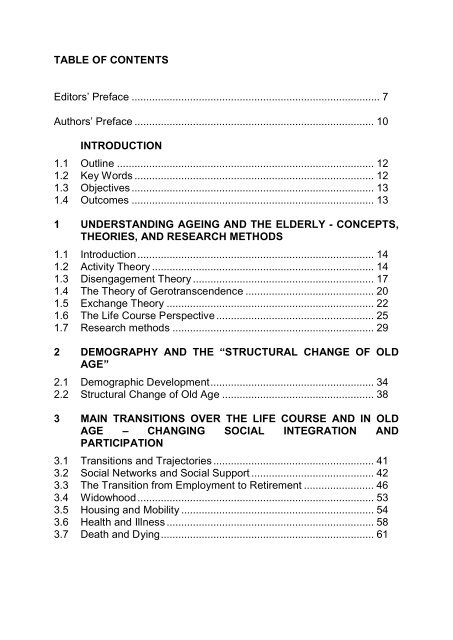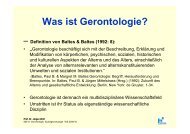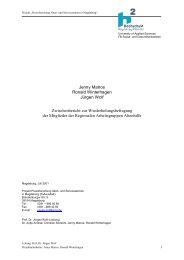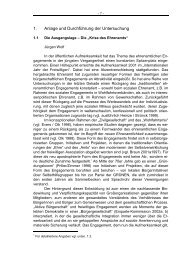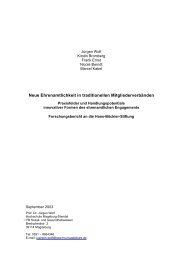TABLE OF CONTENTS Editors' Preface ... - Jurgenwolf.de
TABLE OF CONTENTS Editors' Preface ... - Jurgenwolf.de
TABLE OF CONTENTS Editors' Preface ... - Jurgenwolf.de
You also want an ePaper? Increase the reach of your titles
YUMPU automatically turns print PDFs into web optimized ePapers that Google loves.
<strong>TABLE</strong> <strong>OF</strong> <strong>CONTENTS</strong><br />
Editors’<strong>Preface</strong> ..................................................................................... 7<br />
Authors’<strong>Preface</strong> .................................................................................. 10<br />
INTRODUCTION<br />
1.1 Outline ........................................................................................ 12<br />
1.2 Key Words .................................................................................. 12<br />
1.3 Objectives ................................................................................... 13<br />
1.4 Outcomes ................................................................................... 13<br />
1 UNDERSTANDING AGEING AND THE ELDERLY CONCEPTS,<br />
THEORIES, AND RESEARCH METHODS<br />
1.1 Introduction................................................................................. 14<br />
1.2 Activity Theory ............................................................................ 14<br />
1.3 Disengagement Theory .............................................................. 17<br />
1.4 The Theory of Gerotranscen<strong>de</strong>nce ............................................ 20<br />
1.5 Exchange Theory ....................................................................... 22<br />
1.6 The Life Course Perspective...................................................... 25<br />
1.7 Research methods ..................................................................... 29<br />
2 DEMOGRAPHY AND THE “STRUCTURAL CHANGE <strong>OF</strong> OLD<br />
AGE”<br />
2.1 Demographic Development........................................................ 34<br />
2.2 Structural Change of Old Age .................................................... 38<br />
3 MAIN TRANSITIONS OVER THE LIFE COURSE AND IN OLD<br />
AGE – CHANGING SOCIAL INTEGRATION AND<br />
PARTICIPATION<br />
3.1 Transitions and Trajectories....................................................... 41<br />
3.2 Social Networks and Social Support .......................................... 42<br />
3.3 The Transition from Employment to Retirement ........................ 46<br />
3.4 Widowhood................................................................................. 53<br />
3.5 Housing and Mobility .................................................................. 54<br />
3.6 Health and Illness....................................................................... 58<br />
3.7 Death and Dying......................................................................... 61
4 COMPARATIVE SOCIAL POLICY<br />
4.1 Introduction................................................................................. 65<br />
4.2 Pension Systems........................................................................ 66<br />
4.3 Medical System / Health Care.................................................... 70<br />
4.4 Social Care for the El<strong>de</strong>rly.......................................................... 73<br />
5 EXCLUSION<br />
5.1 “Ageism”: Images of Old Age and Age Discrimination............... 76<br />
5.2 "Generational Equity" and the Shift of Social Policy .................. 79<br />
5.3 Political Participation and the Senior Citizens' Movement......... 82<br />
6 INTERVENTION......................................................................... 86<br />
7 VISIONS<br />
7.1 Late Mo<strong>de</strong>rnity and Ageing ........................................................ 88<br />
7.2 The Welfare State's Crisis and Future ....................................... 90<br />
7.3 The Risk Society......................................................................... 91<br />
7.4 Trust in the Risk Society............................................................. 94<br />
7.5 Ageing in the Risk Society.......................................................... 95<br />
8 QUESTIONS ........................................................................... 102<br />
9 EXAMINATION TASKS ........................................................... 105<br />
10 REFERENCES / LITERATURVERZEICHNIS......................... 226<br />
ÄLTERE MENSCHEN AUS EUROPÄISCHEN BLICKWINKELN<br />
(GERMAN VERSION / DEUTSCHE VERSION)............................... 109
AUTHORS’PREFACE<br />
Throughout Europe, there is a booming interest in the El<strong>de</strong>rly. In<br />
the context of the “European year of the El<strong>de</strong>rly and of solidarity between<br />
Generations”, in 1993, the living conditions and attitu<strong>de</strong>s of ol<strong>de</strong>r people<br />
have been <strong>de</strong>scribed statistically for the first time on the European level.<br />
In 1999, the Commission of the European Communities published it’s<br />
communication paper “Towards a Europe for all ages – promoting<br />
prosperity and intergenerational solidarity”in which amongst other things<br />
the rights of ol<strong>de</strong>r people in the labour market, the sustainability of<br />
pensions, and a highquality standard of health care have been pointed<br />
out as tasks for European politics.<br />
This wi<strong>de</strong>spread attention is motivated mainly by the <strong>de</strong>mographic<br />
<strong>de</strong>velopment, which results in an increase of the el<strong>de</strong>rly population.<br />
Historically, this <strong>de</strong>velopment is unique, and the respective societies are<br />
not properly prepared to <strong>de</strong>al with its consequences. The growing<br />
proportion of ol<strong>de</strong>r people is consi<strong>de</strong>red often as an economic and<br />
socialpolitical bur<strong>de</strong>n, which will overstrain the social security system<br />
and impe<strong>de</strong> innovations. On the other hand, the social situation of the<br />
el<strong>de</strong>rly has improved remarkably. Most people survive until old age,<br />
which does not necessarily mean poverty, illness and social isolation any<br />
more. But this very progress of the social conditions and social political<br />
provisions turns the el<strong>de</strong>rly into a target group for cuts and limitations of<br />
resources like pensions, health and social care. Ol<strong>de</strong>r people aren’t a<br />
“problem group”per se but they remain vulnerable and being at risk of<br />
social exclusion. Cultural values and norms of respect and legitimacy of<br />
old age security limit the specific vulnerability of ol<strong>de</strong>r people, as we<br />
have un<strong>de</strong>rstood it up till now. The more these moral and normative<br />
boundaries become fluid, and the more productivist and utilitarist<br />
orientations gain a dominant role, the more difficult a policy will be which<br />
consi<strong>de</strong>rs itself being committed to the aim of “adding life to years”<br />
(Commission 1999).<br />
Against this background we <strong>de</strong>al in our book with the processes of<br />
ageing and the social conditions of the el<strong>de</strong>rly in Europe. First we give an<br />
overview of the most important theoretical approaches in social<br />
gerontology, the methodological problems of research in the field of<br />
ageing, and the main elements of the <strong>de</strong>mographic <strong>de</strong>velopment. The<br />
social conditions of ageing and of ol<strong>de</strong>r people’s lives are consi<strong>de</strong>red in<br />
the light of important transitions in the later phases of the life course,
followed by an outline of the social political regulations of the risks<br />
connected to these transitions. We also consi<strong>de</strong>r questions of social<br />
exclusion and inclusion on the basis of selected examples. The visions of<br />
ageing in future Europe are neither clearly optimistic nor pessimistic.<br />
They are based on a view on society, which is characterized by an<br />
increase of risks, which in our present society have to be mastered in an<br />
individualistic manner.<br />
For a book, which primarily serves as the basis of a study course<br />
module, we had to make compromises between the wealth of information<br />
and the restrictions of size. Important issues like the history of old age or<br />
the social situation and life perspectives of ageing migrants could not be<br />
inclu<strong>de</strong>d in this text. However we hope to present a sufficient and<br />
comprehensive overview, which can be useful for the pursuit of <strong>de</strong>tailed<br />
studies of individual and societal aspects of an “ageing Europe”.<br />
Because of the lack of empirical data and information in hand we<br />
refer to the 15 present member nations within the union (until May 2004).<br />
The conditions <strong>de</strong>scribed in the empirical chapters will take on new<br />
dimensions through the admission of 10 new member states, which will<br />
require renewed studies in the future.


